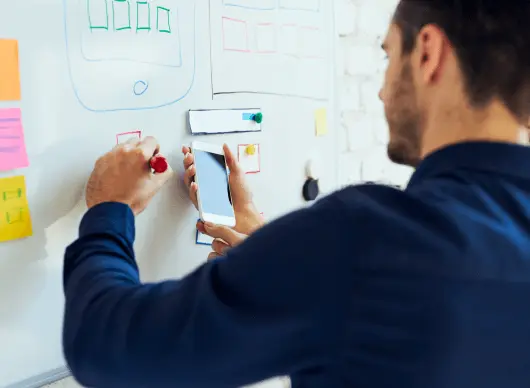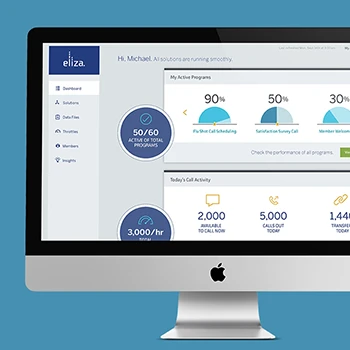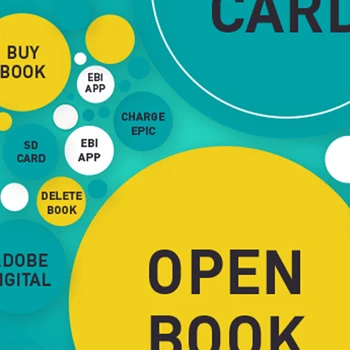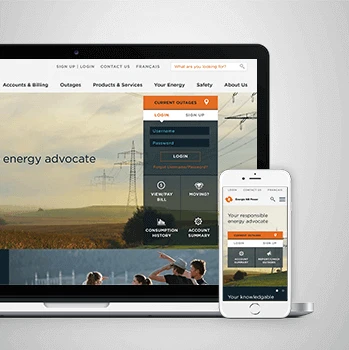What makes a multi-disciplinary UX team different from traditional design groups?
Multi-disciplinary UX combines diverse specialties under unified leadership to create holistic experiences. Through our Experience Thinking framework, we integrate brand, content, product, and service design disciplines that work together rather than in silos. This approach ensures all touchpoints align toward common experience goals.
Tip: Evaluate potential partners based on how well their different disciplines actually collaborate on projects rather than just listing available specialties.
How do you structure roles within a multi-disciplinary team?
Our structure includes strategists, researchers, interaction designers, visual designers, service designers, and developers working as integrated units. Each specialist contributes their expertise while understanding how their work connects to the broader experience ecosystem. We assign clear ownership while maintaining collaborative workflows.
Tip: Ensure each discipline has dedicated representation rather than expecting one person to cover multiple specialties effectively.
What credentials should we expect from team members?
Our multi-disciplinary team includes specialists with backgrounds in behavioral science, data analytics, engineering, experience design, and systems thinking. This combination provides both academic rigor and practical application across different experience challenges. Each member brings deep domain expertise plus collaborative skills.
Tip: Focus on finding professionals who combine formal training with hands-on experience in their specialty areas.
How do different disciplines communicate and coordinate work?
We use shared frameworks and common language to bridge different professional backgrounds. Regular cross-discipline reviews, integrated planning sessions, and unified documentation ensure alignment. The Experience Thinking approach provides structure for how brand, content, product, and service specialists work together.
Tip: Establish clear communication protocols and shared success metrics from the beginning of any engagement.
What's the typical team size for multi-disciplinary projects?
Team size varies based on project complexity, from 3-5 people for focused initiatives to 6-8 for large-scale transformations. We scale resources to match your specific needs while maintaining the collaborative dynamics that make multi-disciplinary work effective. Each project gets the right mix of specialties.
Tip: Start with a core team of key disciplines and expand as project requirements become clearer rather than over-resourcing from the beginning.
How do you maintain quality across different specialties?
Quality standards are maintained through peer review, unified methodologies, and regular quality checkpoints across all disciplines. Each specialist reviews work from adjacent disciplines to ensure coherence. We have established processes for maintaining consistency while allowing disciplinary expertise to shine.
Tip: Implement cross-disciplinary review processes rather than relying on individual specialists to self-police their work quality.
What happens if there are conflicts between different disciplinary perspectives?
We resolve conflicts through user-centered decision making and evidence-based discussions. When disciplines disagree, we return to user research findings and business objectives to guide decisions. Our Experience Thinking framework provides neutral ground for evaluating different perspectives based on experience impact.
Tip: Establish clear decision-making hierarchies and conflict resolution processes before disagreements arise during project execution.
How does Experience Thinking differ from traditional UX approaches?
Experience Thinking expands beyond individual touchpoint optimization to orchestrate connected experiences across brand, content, product, and service areas. Rather than perfecting isolated components, we design holistic experience ecosystems that create customer loyalty through intentional journey progression from awareness to advocacy.
Tip: Map your current experience gaps across all four quadrants to identify where disconnected efforts might be limiting overall impact.
What are the four quadrants of Experience Thinking?
The framework includes Brand experience (how people feel your values and promise), Content experience (how information and functionality is consumed), Product experience (interaction usability and delight), and Service experience (support and relationship management). Each area requires specialized skills while connecting to the others for complete experience delivery.
Tip: Audit your current capabilities against all four areas to identify where you have strength versus where you need external expertise.
How do you ensure all four experience areas work together?
We create experience architecture that maps connections between brand promise, content strategy, product functionality, and service delivery. Each quadrant reinforces the others through consistent principles, shared customer understanding, and coordinated touchpoint design. The approach treats experiences as interconnected systems rather than separate channels.
Tip: Develop shared principles and success metrics that apply across all experience areas rather than optimizing each area independently.
What role does foresight design play in Experience Thinking?
Foresight design helps us anticipate future user needs and technological changes while designing current experiences. We incorporate scenario planning and trend analysis to create adaptable experience foundations that can evolve with changing customer expectations and market conditions. This forward-thinking approach prevents experiences from becoming obsolete.
Tip: Include future-state visioning in your experience strategy to avoid creating solutions that won't scale with changing user expectations.
How does Experience Thinking handle omnichannel consistency?
Rather than forcing identical experiences across channels, we design for experience coherence that respects channel strengths while maintaining brand consistency. The framework ensures customers feel they're engaging with one organization regardless of touchpoint, while optimizing each channel for its specific capabilities and user context.
Tip: Focus on consistent experience principles and emotional outcomes rather than trying to replicate identical interactions across different channels.
What's the difference between customer journey mapping and Experience Thinking?
Journey mapping typically documents current or desired customer flows, while Experience Thinking provides a strategic framework for designing those journeys across all four experience areas. We use journey mapping as one tool within the broader approach of orchestrating brand, content, product, and service touchpoints into cohesive experiences.
Tip: Use journey mapping to understand current state, then apply Experience Thinking framework to design improved end-to-end experiences.
How do you measure success across the four Experience Thinking areas?
We establish metrics that track both individual quadrant performance and cross-quadrant synergies. Brand metrics include trust and recognition, content measures engagement and task completion, product tracks usability and satisfaction, while service monitors resolution and loyalty. We also measure how these areas reinforce each other.
Tip: Create measurement frameworks that capture both individual touchpoint performance and overall experience ecosystem health.
How do you determine which disciplines are needed for our specific project?
We conduct initial discovery to understand your experience challenges, current capabilities, and strategic objectives. This assessment reveals which aspects of brand, content, product, and service experience need attention, informing the disciplinary mix required. We match team composition to your specific gaps and opportunities.
Tip: Be honest about your internal capabilities and constraints so external support can complement rather than duplicate existing strengths.
What's your typical project methodology?
Our approach follows discover, design, and test phases with all disciplines participating throughout. We begin with collaborative research, move through integrated design sprints, and conclude with multi-disciplinary validation. This ensures each specialty contributes to solution development rather than working in sequential handoffs.
Tip: Plan for overlapping work phases rather than expecting linear progression from research through design to testing.
How do you handle projects that need both innovation and maintenance?
We structure dual-track approaches that allocate resources between breakthrough innovation and operational improvements. Innovation tracks explore new possibilities while maintenance tracks optimize existing experiences. This balance ensures immediate improvements while building future capabilities through foresight design principles.
Tip: Allocate specific percentages of your UX investment to pure exploration versus incremental optimization rather than trying to do both simultaneously.
What deliverables can we expect from a multi-disciplinary engagement?
Deliverables include strategic frameworks, research insights, design systems, prototypes, testing reports, and implementation guidance tailored to your needs. Each discipline contributes specialized outputs while collaborating on integrated deliverables like experience blueprints and journey designs that span multiple areas.
Tip: Define success criteria and preferred deliverable formats upfront to ensure outputs match your internal workflow and decision-making needs.
How do you adapt methodology for different industries or contexts?
While our Experience Thinking framework remains consistent, we adapt methods and focus areas based on industry requirements, regulatory constraints, and user contexts. Technology companies might emphasize product experience, while service organizations focus more on operational touchpoints. Each project receives customized approaches.
Tip: Share industry-specific constraints and requirements early so methodologies can be adapted appropriately rather than forcing generic approaches.
What's your approach to working with existing internal design resources?
We integrate with internal capabilities rather than replacing them, providing specialized expertise and methodological guidance while building internal capacity. Our approach includes knowledge transfer, collaborative work sessions, and mentoring to strengthen your team's multi-disciplinary capabilities over time.
Tip: Plan for knowledge transfer and capability building from the beginning rather than treating external engagement as purely tactical support.
How do you handle tight timelines while maintaining multi-disciplinary quality?
We use compressed methodologies like design sprints and parallel work streams to accelerate delivery without sacrificing collaboration. Time constraints require disciplinary specialists to work more intensively together, often producing better integration than extended timelines that allow siloed work to develop.
Tip: Consider intensive collaborative approaches for urgent projects rather than trying to maintain traditional sequential workflows under time pressure.
How do you conduct user research across multiple disciplines?
We design research that captures insights relevant to brand, content, product, and service experiences simultaneously. Rather than separate research for each discipline, we use integrated methods that reveal how users experience your complete offering. This prevents conflicting findings and ensures shared understanding across specialties.
Tip: Structure research questions to capture insights across multiple experience areas rather than conducting separate studies for each discipline.
What research methods work best for multi-disciplinary insights?
Journey mapping, service safaris, contextual interviews, and participatory design workshops provide rich insights across disciplines. These methods reveal both individual touchpoint performance and cross-touchpoint relationships. We combine behavioral observation with attitudinal research to understand both what users do and why they do it.
Tip: Use research methods that capture both individual interactions and broader relationship dynamics rather than focusing only on task-level usability.
How do you synthesize findings across different specialties?
Synthesis sessions include representatives from all disciplines to ensure findings are interpreted from multiple perspectives. We use collaborative analysis techniques and shared frameworks to identify insights that span disciplines. The Experience Thinking approach provides structure for connecting research findings to design implications.
Tip: Include all disciplines in research synthesis rather than having researchers interpret findings for other specialties secondhand.
What's your approach to competitive analysis across experience areas?
We analyze competitors' complete experience ecosystems rather than just interface features. This includes brand positioning, content strategy, product functionality, and service delivery to understand their integrated experience approach. Competitive intelligence reveals both direct interface comparisons and strategic positioning opportunities.
Tip: Analyze competitor experiences holistically rather than just benchmarking individual features or design patterns in isolation.
How do you validate design concepts across multiple disciplines?
Validation includes concept testing, prototype evaluation, and pilot program assessment that spans all relevant experience areas. We test how brand concepts resonate, how content performs, how products function, and how services deliver. Multi-disciplinary validation prevents solutions that work in isolation but fail as integrated experiences.
Tip: Test experience concepts as complete systems rather than validating individual components separately and assuming they'll work together.
What role does data analytics play in multi-disciplinary research?
Analytics provide quantitative insights that complement qualitative research across all experience areas. We track behavioral patterns, engagement metrics, conversion flows, and satisfaction scores to understand experience performance. Data helps validate qualitative insights and identify areas needing deeper investigation through foresight design approaches.
Tip: Combine quantitative behavioral data with qualitative insights to understand both what's happening and why it's happening across your experience ecosystem.
How do you research future needs and emerging trends?
We conduct trend analysis, scenario planning, and emerging technology assessment to understand evolving user expectations. This forward-looking research informs experience strategies that remain relevant as markets change. Research includes both current state understanding and future opportunity identification through systematic trend monitoring.
Tip: Allocate research resources to understanding emerging trends and future scenarios rather than focusing exclusively on current user needs and behaviors.
How do design systems work across multiple disciplines?
Our design systems encode principles for brand expression, content organization, interaction patterns, and service delivery standards. Rather than just visual components, we create experience systems that guide decision-making across all touchpoints. This ensures consistency while allowing appropriate adaptation for different contexts and channels.
Tip: Develop design systems that include guidelines for all experience areas rather than limiting systems to visual and interaction components only.
What components are included in multi-disciplinary design systems?
Components include brand voice and tone guidelines, content templates and structures, interaction patterns and behaviors, visual elements and layouts, plus service standards and workflows. Each component connects to others through shared principles and consistent application across different experience touchpoints and channels.
Tip: Create design system components that specify both individual usage and cross-component integration rather than treating elements as independent pieces.
How do you maintain design systems across different specialties?
Governance includes representatives from each discipline with clear ownership and contribution processes. We establish update procedures, quality standards, and communication protocols that enable distributed teams to extend systems appropriately. Regular reviews ensure system evolution matches changing needs while maintaining coherence.
Tip: Establish clear governance roles and processes for design system evolution rather than assuming informal coordination will maintain quality over time.
How do design systems enable innovation while maintaining consistency?
Systems provide principled foundations that enable appropriate variation rather than rigid templates that stifle creativity. We design systems that encode strategic intentions and quality standards while allowing tactical adaptation for specific contexts. This balance supports both innovation and coherence across experience touchpoints.
Tip: Design systems based on principles and outcomes rather than specific implementations to enable creative solutions while maintaining strategic consistency.
What's your approach to design system documentation?
Documentation includes usage guidelines, implementation examples, and decision-making frameworks accessible to all disciplines. We create documentation that explains not just how to use components but why they exist and how they connect to broader experience strategies. This helps teams make appropriate decisions independently.
Tip: Document design system rationale and strategic connections rather than just providing component specifications and usage instructions.
How do you measure design system effectiveness?
Effectiveness measures include adoption rates, consistency improvements, efficiency gains, and experience quality metrics. We track both system usage and experience outcomes to understand whether systems actually improve experience delivery. Measurement includes quantitative adoption data and qualitative feedback from system users.
Tip: Measure design system success through both adoption metrics and experience outcomes rather than just tracking component usage statistics.
How do design systems evolve with changing technology and user needs?
Evolution processes include regular review cycles, emerging technology assessment, and user feedback integration. We design systems with extensible architectures that accommodate new requirements without fundamental reconstruction. This includes foresight design approaches that anticipate future needs and plan for adaptability.
Tip: Build design systems with extensible architectures and evolution processes rather than trying to solve every current and future use case at the component level.
How do you facilitate collaboration between different specialties?
We use structured workshops, shared planning sessions, and collaborative design methods that leverage each discipline's expertise while building mutual understanding. Cross-disciplinary collaboration requires intentional facilitation and shared frameworks like Experience Thinking to bridge different professional languages and approaches.
Tip: Invest in professional workshop facilitation and structured collaboration methods rather than expecting informal coordination to create effective cross-disciplinary teamwork.
What tools and processes support multi-disciplinary collaboration?
Tools include collaborative design platforms, shared documentation systems, integrated project management, and communication channels that enable real-time coordination. Processes include regular cross-discipline reviews, integrated planning cycles, and shared accountability systems that align different specialties toward common objectives.
Tip: Choose collaboration tools and processes that support real-time coordination rather than sequential handoffs between different disciplines.
How do you handle different working styles across disciplines?
We accommodate different working preferences while establishing shared standards for communication, documentation, and quality. Some disciplines prefer iterative exploration while others need structured planning. Our approach respects these differences while creating integration points that ensure alignment and mutual understanding.
Tip: Establish clear integration points and shared standards while allowing disciplines to work in their preferred styles between coordination moments.
What's your approach to stakeholder engagement across disciplines?
Stakeholder engagement includes representatives who can speak to all experience areas rather than separate presentations from each discipline. We create integrated communication that shows how different specialties contribute to overall objectives. This prevents stakeholder confusion and enables holistic decision-making.
Tip: Present integrated recommendations that show cross-disciplinary connections rather than separate updates from each specialty area.
How do you maintain project momentum with multiple disciplines?
Momentum requires clear milestones, regular coordination, and shared visibility into project progress across all disciplines. We use integrated planning and progress tracking that shows how each specialty contributes to overall advancement. This prevents bottlenecks and maintains forward progress across the entire team.
Tip: Create project visibility and milestone structures that track cross-disciplinary progress rather than managing each specialty area independently.
What role does leadership play in multi-disciplinary coordination?
Leadership provides strategic direction, conflict resolution, and resource allocation that enables different disciplines to work effectively together. Strong leadership creates shared understanding of objectives and maintains focus on integrated outcomes rather than individual disciplinary optimization. This guidance is essential for complex project success.
Tip: Ensure project leadership has authority and capability to coordinate across different disciplines rather than just managing individual specialty areas separately.
How do you build long-term relationships across different specialties?
Long-term relationships develop through repeated collaboration, shared successes, and mutual professional respect built over multiple projects. We invest in team development, cross-training opportunities, and social connection that strengthen professional relationships beyond individual project requirements. Strong relationships improve collaboration quality over time.
Tip: Invest in relationship building and team development activities that extend beyond individual project deliverables and deadlines.
How do you integrate AI tools across different design disciplines?
AI integration varies by discipline, with research teams using AI for data analysis and pattern recognition, designers using AI for concept generation and system optimization, and developers using AI for code assistance and testing automation. We maintain human oversight for strategic decisions while leveraging AI for efficiency and capability enhancement across all disciplines.
Tip: Start AI integration with data analysis and pattern recognition tasks rather than strategic decision-making to build confidence and understanding before expanding AI involvement.
What's your approach to emerging technology assessment?
We conduct systematic technology evaluation that considers impact across brand, content, product, and service experiences rather than just technical capabilities. Assessment includes user adoption patterns, implementation requirements, and strategic alignment. This holistic evaluation prevents technology adoption that optimizes one area while disrupting others.
Tip: Evaluate emerging technologies based on complete experience impact rather than just individual discipline benefits or technical capabilities.
How do you maintain human-centered design with increasing automation?
Automation enhances human capabilities rather than replacing human judgment in experience design. We use technology to accelerate research analysis, generate design variations, and optimize system performance while maintaining human oversight for strategic decisions, creative direction, and ethical considerations. The focus remains on human-centered outcomes.
Tip: Use automation to enhance human capabilities and free up time for strategic thinking rather than trying to automate core design decision-making.
What role does foresight design play in technology planning?
Foresight design helps us anticipate how emerging technologies will affect user expectations and experience requirements. We incorporate technology trend analysis and scenario planning to create experience foundations that can adapt to technological change. This forward-thinking approach prevents experiences from becoming obsolete as technology evolves.
Tip: Include technology trend analysis in your experience strategy to avoid creating solutions that won't adapt to changing technological capabilities.
How do you handle technology constraints across different disciplines?
We work within realistic technical constraints while identifying opportunities for experience improvement that don't require major technology changes. Our approach balances ideal experience design with practical implementation requirements. We also identify which constraints are temporary versus permanent to inform long-term strategy.
Tip: Clearly distinguish between current technical constraints and fundamental limitations to identify both immediate and future opportunity areas.
What's your approach to cross-platform experience consistency?
We design for experience coherence that respects platform capabilities while maintaining brand consistency and user expectations. Rather than identical implementations, we create platform-appropriate adaptations that feel connected and consistent. This approach leverages platform strengths while maintaining overall experience integrity.
Tip: Focus on consistent experience principles and emotional outcomes rather than trying to replicate identical functionality across different platforms and technologies.
How do you future-proof experience designs against technological change?
Future-proofing focuses on creating adaptable experience foundations rather than predicting specific technologies. We design based on user needs and experience principles that transcend particular technological implementations. This includes building flexible systems and maintaining user-centered focus regardless of technological change through foresight design principles.
Tip: Design experience strategies based on enduring user needs and adaptable principles rather than specific current technological capabilities.












